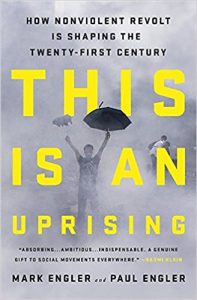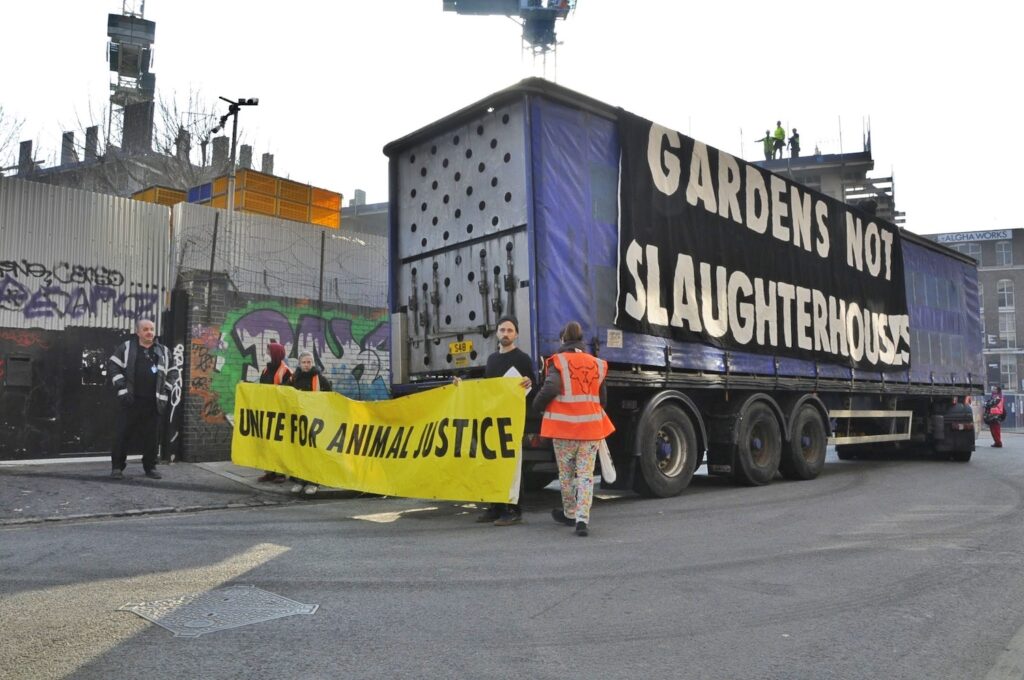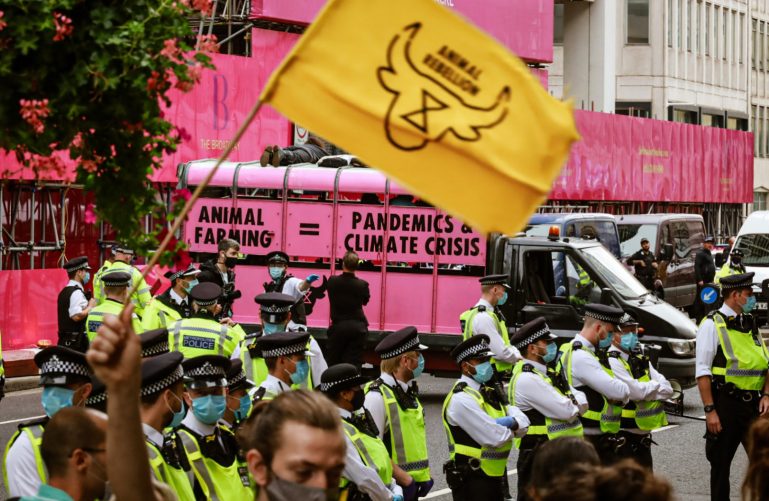Reflections on Rebellion – How People Power can Take the World By Storm
The recent documentary Rebellion tells the story of how Extinction Rebellion went from a vision to a global movement. This blog post reflects on the theory of change behind both Extinction and Animal Rebellion and how we can build transformative people power.
What if I told you that one book held the answers to achieving positive social change? Would you believe me? When I first picked up a book that claimed to do just that, I was sceptical. I was at a stage of my life where, after becoming aware of the scale of injustice affecting animals, humans and our planet, I was increasingly desperate for any glimmer of hope that change could happen.
I remember spending hours and days thinking and talking to friends about what we could do to make change when, one day I stumbled upon a book in a bargain bookshop that changed everything. Years later as I dedicate my time to helping grow Animal Rebellion, it seems almost unbelievable that this very book, which came into my hands so coincidentally, is the very same book that inspired the creation of XR and the subsequent birth of Animal Rebellion. So, what is the research that lies behind Animal Rebellion and Extinction Rebellion and how can one book be so influential?

The book I found that day was ‘This is an Uprising: How Nonviolent Revolt is Shaping the Twenty-First Century,’ written by two brothers: Mark and Paul Engler. The Engler brothers are writers, organisers and social movement researchers who explore the recent history of protest across the world and present a model of social change based on strategic nonviolence and momentum organising. Momentum is a form of social movement which combines structure-based organising with the goal of creating mass moments of mobilisation, where millions of people rise up to demand change.
In their book, the Engler brothers use examples from movements such as the Indian Independence Movement, the Civil Rights Movement, the Serbian ‘Otpor’ Movement and the Arab Spring to show how innovative, creative tactics can topple the ‘pillars of power’ of a corrupt or unjust regime and inspire enough people to take action for change. How much is enough? The book quotes research by political scientist Erica Chenoweth which finds that no movement which has mobilised 3.5% of the population in sustained, active participation has failed to achieve its aims.
Not only that, ‘This is An Uprising’ makes a case for strategic nonviolence, again citing research by Chenoweth showing that nonviolent movements are twice as likely to be successful in their aims as violent ones, a figure which is illustrated by examples from movements which have acted nonviolently for both morally and strategic reasons.
These movements have managed to be more inclusive than their violent counterparts and, importantly, have been able to build public sympathy for the cause and highlight the unjust nature of state violence and repression. For me, this book opened up a whole new world, one which was filled with people who were asking the same questions that I was about how we can make change happen. And, it wasn’t long before the lessons in the book were playing out right in front of my eyes.
For many, the early days of Extinction Rebellion were a transformative and incredible experience. The urgency of the climate crisis paired with the conviction that, as the popular chant goes, the people united could never be defeated inspired thousands of people to take to the streets and hundreds to face arrest.
I watched from the other side of the world and was stunned to see the blueprint laid out in books like ‘This is an Uprising’ come to life. Active popular support + nonviolent action → government declaring a climate emergency within a few months!
It was at this point that Animal Rebellion began, as a small group of people who realised that the same lessons could be applied to the struggle for animal and climate justice. With the same dream of mobilising 3.5% of the population and the same understanding of tools like mass mobilisation and nonviolent action, Animal Rebellion was formed from a plan with impressive proof of design. But, is social change really something that can be planned in advance?
Chenoweth’s research and the conclusions drawn by Mark and Paul Engler have inspired a flurry of groups who are using the model of Momentum-driven organising to create movements for change. From training organisations like Momentum and the Ayni Institute, to grassroots movements such as the Sunrise Movement; the ‘cycle of momentum’ blueprint – which suggest that large-scale change can be achieved through escalating nonviolent action, active popular support and absorption of volunteers – is proving to be enormously popular around the world. Yet, at the same time, there are a number of challenges that arise when putting the ideas in practice.
Cycle of Momentum
Research Context/Liberal Democracy Challenge
One of the most common critiques of the application of Chenoweth’s research in the Momentum organising model is the recognition that the context of the research is notably different from the type of movement it is being applied to. The dataset used in Chenoweth’s research focused on movements seeking to ‘overthrow oppressive regimes, resist foreign occupations, and to secede from a state.’ This is a different context from the one movements like Animal Rebellion and Extinction Rebellion find themselves in, leading to questions about the relevance of the findings and, particularly, the 3.5% rule. In a 2016 interview, Erica Chenoweth stated: “if a nonviolent campaign is aiming for… economic and social justice reforms… Do we see the same types of success rates of violent and nonviolent action? The answer is we don’t know yet because those types of data collection procedures are not yet fully developed.”
What this tells us is that, while this research can provide us with valuable knowledge and insight, we’re yet to see whether the roadmap that has proved so effective for movements to overthrow dictators and oppressive regimes will have the same results with our mission for system change in a liberal democracy.
Additionally, some key features of momentum organising relate to generating public sympathy and support (pg. 18). In previous movements, a key contributor to gaining this kind of support has been the effect of ‘repression backfire,’ where state violence and repression have had the backfire effect of increasing support for the movement. In liberal democracies, repression to protest movements is generally a lot less visible than in oppressive regimes. Violent responses are rare (although not unheard of and are a frequent reality for marginalised communities and, particularly, LGBT+ and BIPOC individuals). State repression often occurs behind the scenes, including through an incomprehensible legal system which has the effect of tying up protestors in endless court proceedings, which often end up with cases being dropped or thrown out.
The tactics that work so effectively against oppressive regimes can fall flat in the political context of the UK. We can see this in the changing of policing tactics following April 2019, which led to significantly decreased media coverage for following rebellions and a large number of unlawful arrests.
Mobilisation Challenge

Another challenge that arises is one of mobilisation. When movements are focused on ending a repressive regime or bringing down a corrupt dictator, this is something that generally affects almost the entire population. Srdja Popovic, one of the leaders of the Serbian Otpor movement, talks about creating a ‘line of division,’ where your messaging clearly speaks to the vast majority of the population, with only the clear villains being on the other side of the line disagreeing with you. The effects of a repressive regime are immediate and visible, they are being felt right at that moment by the people the movement is trying to mobilise. A challenge for movements operating in other contexts is trying to replicate that same sense of personal investment, often without the corresponding direct impacts.
While movements like Occupy and Extinction Rebellion achieved this to a certain extent, mobilising vast amounts of people to demand change, an ongoing struggle for groups like these has been in sustaining this kind of active participation. In the West, we’ll often see a surge of climate action surrounding extreme weather events, particularly ones affecting other Western countries such as the 2019-2020 Australian bushfires.
Between these upsurges of interest however, social movements mostly ‘operate on the margins of success with burnout a common companion to mobilisation’. Momentum organising talks about manufacturing ‘moments of the whirlwind,’ ‘explosions’ where many people suddenly care about your issue. However, it seems obvious that these moments are more likely to take root when people are being directly effected by the focus of your movement. Without the direct effects of a repressive regime being observable to everyone, the challenge of reaching 3.5% active participation is a significant one. This only becomes more challenging when movements seek to advocate for other-than-humans, including movements for animal and climate justice.
The Frontloading Challenge
A final challenge I’ll touch on is the focus that movements following the Momentum Model place on ‘frontloading.’ Frontloading is defined as “engaging in serious, strategic planning,” and “visioning our future while anticipating problems that will come up, so people can make aligned decisions without command and control.” This refers to organisations taking a period of time, generally 12 months or so, to plan out their story, structure, strategy and culture, with the understanding that this will enable the movement to build rapid momentum, mobilisation and escalation while maintaining strong processes, organisation and support structures for people and the organisation.
If we look to current understandings of social change however, we can see that a dominant model of social movements is the ‘framing’ model which regards ‘creating a movement… (as) a cultural enterprise: an idea only ‘moves’ a group if it has cultural resonance.” What will have this resonance is difficult, if not impossible to predict.
Additionally, in a fast-changing environment and media landscape, something which is relevant and important to people will be out of date six months later. This runs the risk of organisations investing a significant amount of resources (time, money, people) into building a movement which may entirely fail to capture the energy and attention of the public.
So is there a golden rule for social change? Theories on social change have evolved over time. Early on, sociologists believed that social movements arose out of discontent which evolved into a belief that a successful movement depended on who could mobilise the right resources (money, people and time) to achieve a desired aim. In the last decade, a body of work referred to as ‘new social movement theory’ has attempted to explain the occurrence of recent social movements by understanding social movements as a “cultural enterprise” which succeed by creating an “injustice frame” which highlights a problem, a solution and a way that people can be part of change.

Current understanding in sociology is that we can’t predict when a social movement will form or if it will be successful. This tells us that, while theories like Momentum are useful models, ultimately there is no golden rule or blueprint for change which will be successful every time. However, drawing together knowledge from a range of sources, there are some things we can say with some confidence:
- The best people to mobilise are closer than you think! A theme across social movement research is that movements succeed in mobilising when active participants are inspired and engaged enough to then mobilise their own friends and families. We can learn from this and focus on giving our base the skills and, importantly, the passion to show those around them why change is needed and why what we’re doing is important.
- A strong, unified vision and messaging that connects to shared values is how we can unite people behind a common goal. Movements with a clear vision and that connect to people’s values, fears and desires are the movements that succeed in overcoming challenges and adapting to change.
- If you want to achieve mass mobilisation and create lasting change, nonviolence is the best way to go.
- There are many theories of change and many ways we have seen change happen over time. By learning from a variety of sources and movements and by remaining flexible, adapting to current situations and not being afraid to innovate, we can learn from the past and build new methods of change that are the best fit for the society we’re living in.
Books like ‘This is an Uprising’ give us important insight which we can use to inspire our campaigns and strategy. What can be even more important though is what we learn when we take these theories and see how they play out on the streets. The relationship between activism and academia can be one of symbiosis where each group grows and thrives alongside one another. While there might not be one silver bullet solution for social change, what does exist is an incredible passion, determination and an extraordinary amount of skills and knowledge. All the movements written about in books like this weren’t following an exact blueprint. They, like us, were learning as they went and using tools and lessons from history to shape pathways forward that made sense in the context they were in. If we come together, aren’t afraid to try new things and learn from our mistakes and successes, what can’t we do?
You can watch the Rebellion documentary on Netflix
Keen to start rebelling and be part of a movement for change? Actions will be happening in London from the 9th – 17th April. Find out more and say you’ll be there by joining our Facebook event here: https://fb.me/e/2lLxYQmBO
You can join our telegram broadcast: https://t.me/joinchat/s17vhYFQ3qY5YTBk
Or our https://chat.whatsapp.com/HYcMc8iZ140BPOxE6yhp09

